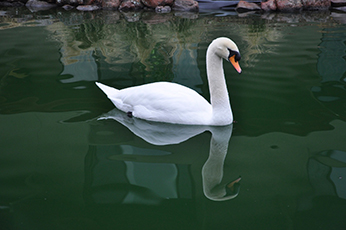(Cygnus olor)
General Description
 Adult mute swan. CDFW photo by Cathie Vouchilas.
Adult mute swan. CDFW photo by Cathie Vouchilas.
Mute swans are very large birds weighing 25 - 30 pounds and measuring 4 - 5.5 feet in length, with a wingspan up to nearly 8 feet. Adult mute swans are solid white with a black face-patch and black to grayish-pink legs with webbed feet. They can be distinguished from other swan species by their orange bill with fleshy, black knob, long “S” shaped neck, and long tail feathers. Juvenile mute swans are either white or dusky in color with a grayish bill. Mute swans are not very vocal, but will grunt, snort, or hiss to communicate, especially if they feel threatened. Use this Swan Identification Sheet (PDF)(opens in new tab) to accurately identify swans in the field.
Current Distribution
In California, mute swans are sometimes kept as aesthetic “pets” at private residences and city park ponds. They have been observed in the wild in Suisun Marsh (Solano County) and Petaluma Marsh Wildlife Area (Marin and Sonoma Counties). Mute swans were introduced to the United States, specifically to New York State, from Western Europe during the late 1800s. They have been reported to occur in numerous states from Washington to New Hampshire and south to Florida, with substantial breeding populations in Chesapeake Bay, Long Island Sound, and the Great Lakes.
Habitat Preference
Mute swans prefer shallow, coastal and freshwater habitats such as estuaries, bays, wetlands, ponds, and lakes. They generally inhabit waterbodies that contain an abundance of submerged aquatic vegetation (SAV), their primary food source. Mute swans nest in an open bowl of aquatic vegetation, grasses, and rushes and can establish territories of 4 - 10 acres. In the United States, mute swans are not migratory; though they will move to deeper waters when shallow areas freeze over.
Pathways
Mute swans are native to northern and central Eurasia and have been domesticated in Western Europe since the 12th century. They were intentionally brought to the United States by private breeders for display at zoos, parks, and private estates. A small number of these swans escaped captivity and others are believed to have been intentionally released. Mute swans continue to be purchased in many states for aesthetic purposes, control of algae and aquatic plants, and to manage nuisance populations of waterfowl. Mute swans continue to be introduced or spread to new states by escaping captivity or dispersing naturally from established populations. Mute swans are on California’s restricted species list and cannot be imported, transported, or possessed without a permit.
Impacts
Mute swans are voracious feeders of SAV, with each adult swan consuming up to 8 pounds per day, and destroying much more in the process. SAV is an important part of aquatic ecosystems as it provides food and shelter for native waterfowl, fish, and invertebrates. By consuming massive amounts of SAV, mute swans negatively impact the structure and function of aquatic habitats native species depend upon. Additionally, mute swans are aggressive towards other birds, as well as people. Mute swans disrupt nesting activity of native waterfowl by chasing birds from their nests and have been reported to physically injure, or even kill, other birds. Mutes swans have been reported to attack people and, in some cases, have critically injured children and pets.
Actions Taken if Found
If you observe this species in California, please report your sighting to the CDFW Invasive Species Program, by email to Invasives@wildlife.ca.gov, or by calling (866) 440-9530.